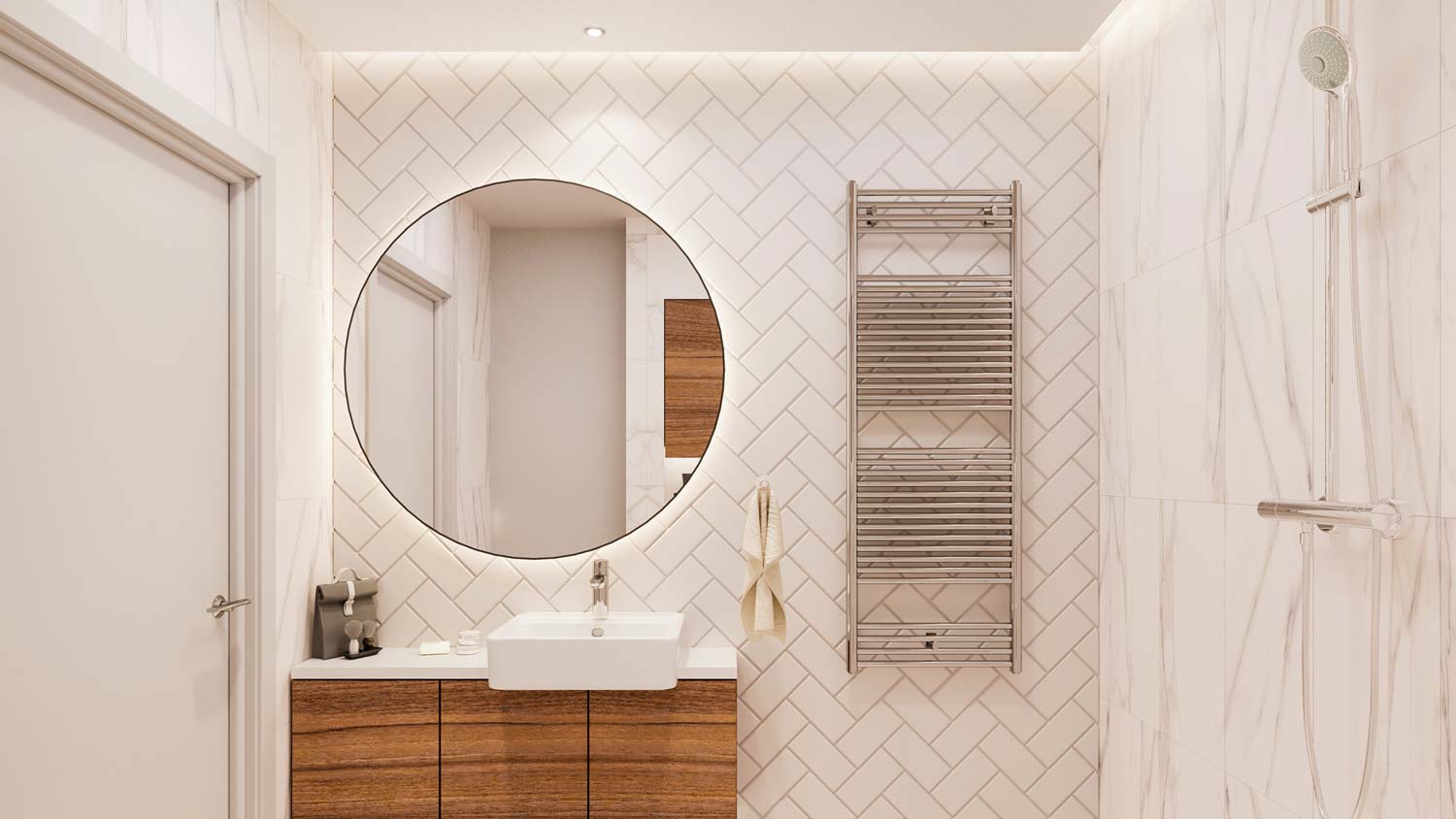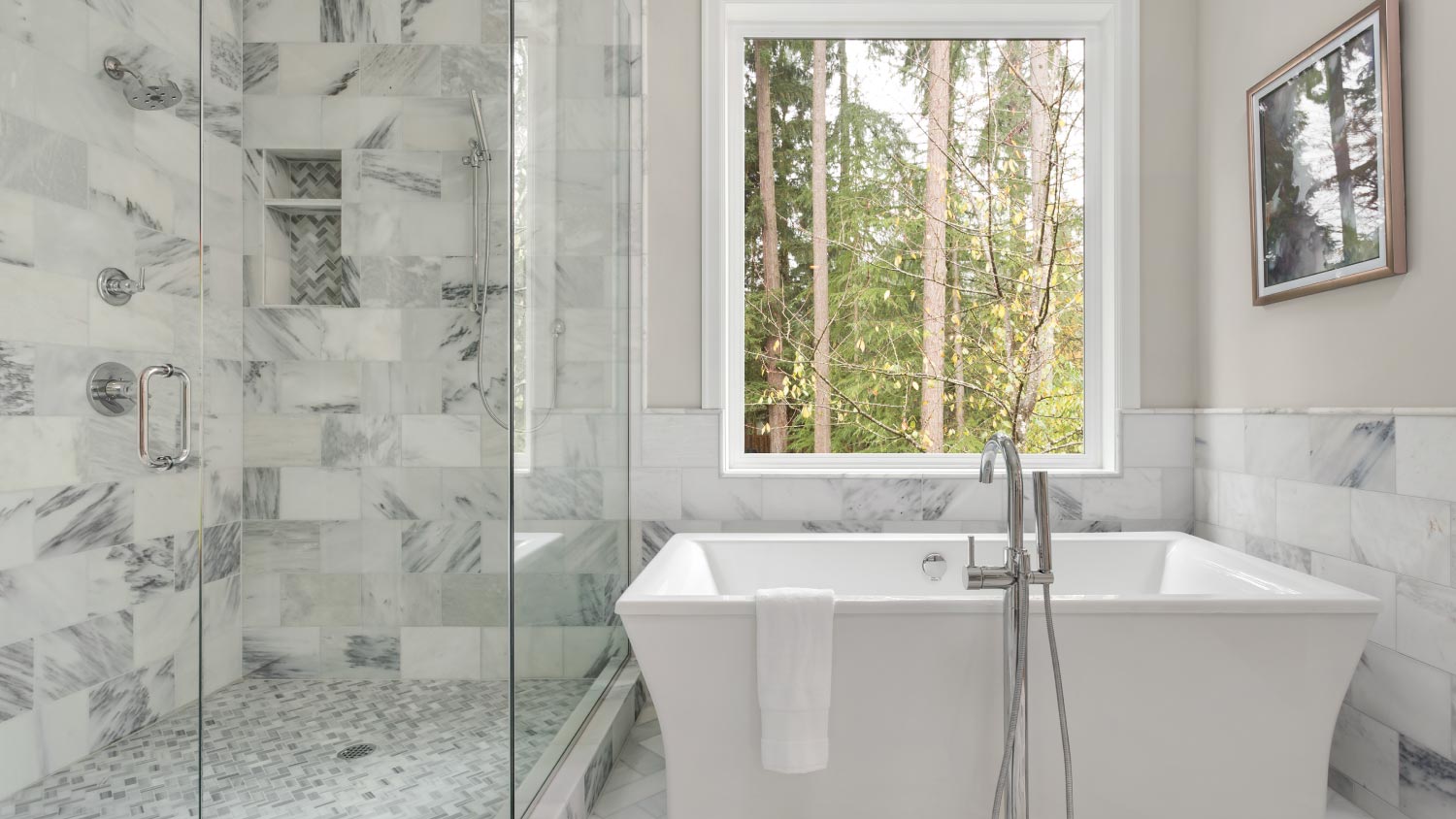
Various factors affect the total tub-to-shower conversion cost, including the size of the area, type of shower, materials, and labor fees.
Make your bathroom remodel seamless—literally


Solid surface showers are easy to clean and resistant to mold and bacteria
It comes in large sheets, so it’s generally easier to install than tile or stone
It’s customizable and comes in a wide variety of colors and designs
Have you ever been envious of those countertops that look like granite but are super easy to clean and far less expensive? They’re made with solid surface, a man-made material consisting mostly of resin—but it’s not just limited to countertops. It also happens to be a great material for showers. So what is it, and why should you use it? Here’s what you need to know about solid surface showers.
If you’ve looked online for bathroom remodel ideas, you’ve likely come across solid surface. This bathroom material is a non-porous composite created from mineral dust (usually alumina trihydrate) mixed with resins and pigments. You can get solid surface in a range of colors and patterns, some even mimicking higher-end natural stone slabs. The most common resins used are acrylic or polyester, though you can have a combination:
Acrylic-based solid surface: It’s easier to get a seamless look with acrylic-based solid surface because it adheres better to other materials. This type of solid surface has a matte look and is highly durable.
Polyester-based solid surface: Polyester-based solid surface is more affordable than acrylic-based solid surface, but it’s also more brittle. The glossy finish and UV-resistance makes it ideal for vibrant colors.
Acrylic and polyester solid surface: This material combines characteristics from both types of resins, making it a solid middle ground.
A shower installer near you can help you pick the right solid surface for your remodel.
There’s a reason solid surface is a popular material. It’s a delicate balance of versatility, durability, price, and ease. It performs particularly well on shower walls thanks to its non-porous, naturally waterproof construction. Here are some major benefits.
The average walk-in shower costs $6,700—though the cost of some shower remodels could hit $15,000. A solid surface shower tends to fall in the middle of the price spectrum, with wall panels for the average 70-square-foot shower running somewhere between $3,500 to $8,400. Couple this with low installation costs (since it’s quicker to install than tile or stone) and you’ve got a deal.
Tip: If you’re looking for a change but don’t have the budget for the cost of a full bathroom remodel, redoing your shower or sink with solid surface makes a big impact with a modest price tag.
Mildew, mold, bacteria, and other nasties pop up in bathrooms due to the extra moisture and humidity. Solid surface materials have a high resin content, so they are non-porous even though they can be styled to have the look of natural stone. Because they’re non-porous, they can resist mildew, mold, and bacteria growth when subjected to a high-moisture area like a shower.
The low porosity of solid surface doesn’t just mean solid surface is antimicrobial—it’s also easier to clean than natural stone or tile. With tile, you have to worry about gritting your teeth to get into the nooks and crannies of the grout seams. With solid surface, you can simply wipe it down with a cloth or sponge, and it stays looking shiny and clean.
Solid surface generally performs better than tile because it comes in one large piece, as opposed to lots of small pieces that are held together by grout. Your contractor won’t need to waterproof underneath solid surface, which they usually have to do with tile because of the potential for water leakage between the pieces. This makes it a good choice for steam showers, which come with added humidity.
Solid surface materials are thermoformable, meaning that they can be heated up and molded into different shapes like a bathtub. So if you’re dreaming of a shower that matches your bathroom counters, then solid surface counters could be the answer. You can get counters cut and a tub molded out of the same material so they match perfectly.
Solid surface counters, tubs, and showers come in a large range of patterns and colors, including solids and stripes, making it a versatile option for different shower designs and tub-to-shower conversions. Solid surface can be styled to look like a natural material without the higher price tag of natural stone.

Unlike tile, which has to be put together piece by piece, solid surface panels can be put together in large pieces to create a seamless look.
Just like furniture, fixtures in your shower can get scratched or dinged over the years. With solid surface, you can sand and refinish the surface of your tub, sink, or shower to look as good as new. Replacing counters, tubs, and shower walls can be a costly task, so having a material you can restore to its original perfect sheen is a money saver.
Although solid surface material is usually very shiny and looks slippery, you can opt to get it lightly textured, making it safer for people with mobility issues. This is a popular feature when converting a tub to a walk-in-shower. Not only does this remodel eliminate the risk of tripping over a tub wall, it also helps prevent slips.
Solid surface usually comes in large pieces, so the installation takes less time than laying tile. A bathroom remodeler near you should be able to do the job, so you can get back to designing your dream bathroom.
From average costs to expert advice, get all the answers you need to get your job done.

Various factors affect the total tub-to-shower conversion cost, including the size of the area, type of shower, materials, and labor fees.

The cost to install a window seat depends on several factors, such as materials, labor, and options. Here’s a breakdown of the cost to install a window seat.

Building a guest house is one of the largest home projects and involves several different professionals. Learn about the cost to build a guest house and where you can save.

When comparing a steam shower versus a sauna, some factors can impact which one is best for you, including installation, temperature, treatment, and cost.

Knowing how to install a shower requires some skill and experience, but a shower enclosure installation is a doable DIY project if you follow some basic steps.

An updated bathtub can give a bathroom a whole new look. Find out how much it costs to replace a bathtub in Atlanta, GA, including prices by type and labor costs.